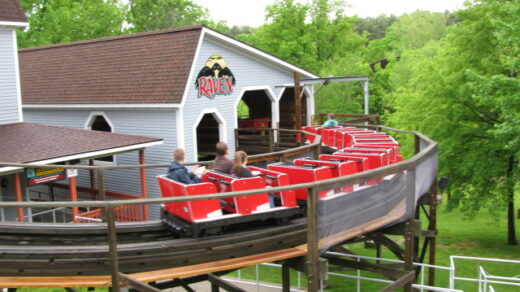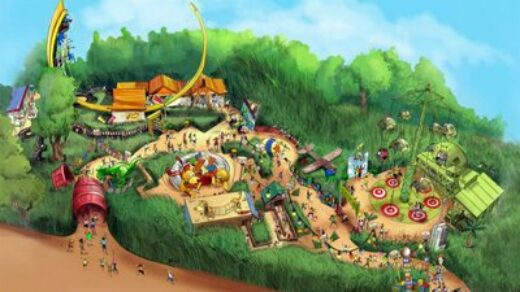In these rough economic times and through all the parks we’ve lost over the last few years, it’s nice to hear that family-owned parks are doing well for the most part. From the New York Times:
 WILDWOOD, N.J. — Given that consumers have been so reluctant to spend lately, the family-run amusement park would seem especially vulnerable.
WILDWOOD, N.J. — Given that consumers have been so reluctant to spend lately, the family-run amusement park would seem especially vulnerable.
“We had a lousy, wet June and a couple of hurricane threats this summer, so that was bad,” said Jack Morey, who with his brother Will, owns and runs three amusement piers along the Wildwood boardwalk. “Then the weather got better in August, and suddenly everyone was there.”
If they have sunshine and moderate temperatures, Mr. Morey and his fellow owners around the country say, the slower economy seems to be favoring them.
Indeed, the fact that most of the independent parks are owned by families may insulate them a bit from the normal business cycles, said William Alexander, who teaches courses in family business at the Wharton School at the University of Pennsylvania. “In many cases, these are seasonal businesses,” Mr. Alexander said. “And in the summer, the whole family would participate. In difficult economic times, particularly, a family committed to a business will sacrifice in deferring compensation and bonuses.”
Mr. Alexander also noted that the family-run amusement parks were generally “not as involved as the large ones in the amusement arms race, where building the next big roller coaster is the goal.” As a result, he said, “Their capital cost structures are not as stretched.”
Six Flags, which runs the Great Adventure Parks, filed for Chapter 11 bankruptcy protection in June. New owners took over in 2005 after the company had increased its debt through expansion and spending on gigantic roller coasters. When it filed for bankruptcy, the current managers said that park attendance had held up over the last couple of years, but that revenue was not adequate to cover its debt.
Family-operated parks run the gamut from places like Storybook Land, an amusement park in Cardiff, N.J., about a dozen miles west of Atlantic City, that offers smaller rides aimed at younger children, to places like Morey’s Piers, which have roller coasters just short of the Six Flags-type screamers. Most have 20 to 50 rides or attractions, sometimes water parks, and often arcades or shows. They are day-trip places, with passes that stay firmly in the low- to mid-double-digit dollar range. A day pass for one of the Six Flags parks costs $45 to $55 a person, and parking is at least $15.
“We feel in competition with places like Six Flags,” said Dick Andrew, vice president of marketing at the Lagoon and Pioneer Village, a 49-ride park in Farmington, Utah, which opened in 1886, 10 years before Utah became a state. “Denver has a Six Flags and that is 600 miles away, and the large parks in California are more than 700 miles away. But people here in Utah think nothing of loading up the kids in the van and just driving. We always have to be aware that the customer isn’t just going to come here because we are down the road.”
Thus, the family amusement parks have to be both keepers of nostalgia and up-to-date. In Wildwood, the Moreys say they try to come up with at least one new ride or attraction a year, but still have the old bumper cars and carousel. At the Santa Cruz Beach Boardwalk in that central California seaside town, the Canfield family, which has owned the park for more than a century, decided not long ago to replace the Haunted Castle ride that had been showing wear after 30 years in operation.
“But we asked around and you know what we replaced it with? An updated Haunted Castle ride,” said Marq S. Lipton, the company’s vice president of marketing and sales. “It is an advantage to be working for a company that has been in business for more than 100 years. You have seen just about every type of economy. You can let the past help guide your future actions and plans.”
Even though the economy did not devastate the family parks, it did lead many of them to re-evaluate what the future might bring. At Wild West City, a 53-year-old park in northwestern New Jersey with an old-time Western village, some rides and a mock shootout and Western show on the Main Street every hour or so in the summer, there are often obstacles just to staying in business.
“Our cap-gun supplier went out of business two years ago,” said Wild West City’s manager, Mary Benson. “Who would figure that? So we had to find someone else, which was more expensive.” Licensing and insurance goes up every year, she said, and the minimum wage, which is what many young seasonal workers often get, jumped in New Jersey to $7.25 this year from $6.15 an hour in 2006. Corporate business — companies throwing picnics and the like — has declined but, she said, will hopefully come back when the economy improves.
“We’re managing, but we do it because we love it,” she said, noting that the owner, Mike Stabile, whose family bought the park in 1963, still gets out on the Main Street daily to do the lasso show.
There have been at least three closings of long-term amusement parks this year, according to Jim Futrell, the historian for the National Amusement Park Historical Association and the writer of four books on amusement parks. But all those, he said, had family-based disagreements, and were not related to the general economy. In the early part of the decade, though, he said, several seaside parks in places like Myrtle Beach and the Outer Banks and the New Jersey shore closed because the land along the ocean just became too valuable.
“The ironic thing, though, is that most all of that land lies vacant today,” he said. “It never did become condos or housing developments,” he said. In fact, in one place, Sea Isle City, N.J., the town leased back the land to an amusement operator this summer. John Fricano, owner of Storybook Land, which has been in his family for 54 years, said the family amusement park offered a form of stability to customers. “People know what we have to offer, and well, we have been lucky that they always come back,” he said. “There are always new kids and, for the most part, this business is about kids and their families. Now the original kids bring their kids.”















Recent Discussion